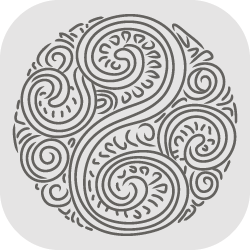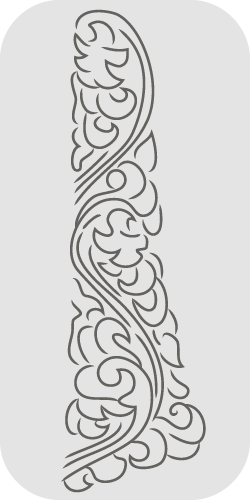- Object Date
- Goryeo 고려 高麗 dynasty (918–1392), late thirteenth or early fourteenth century
- Medium
- Hanging scroll; ink, color, and gold on silk
- Dimensions
- Image: 107.6 X 49.4 cm (42 3/8 X 19 7/16 in.)
Overall: 200.7 X 72.4 cm (79 X 28 1/2 in.)
- Credit Line
- Anonymous gift
- Collection
- Arthur M. Sackler Gallery
- Accession Number
- S1992.11
- Provenance
To 1942
Grandfather of the anonymous donor [1]1942 to 1992
Through descent of the family to the donor [2]From 1992
Arthur M. Sackler Gallery [3]Notes:
[1] According to the gift agreement signed by the donor.[2] See note 1.
[3] See note 1.
- Apparatus
- Outer wooden box; cardboard sleeve
- Past Label Text
Featured object, June 30–October 25, 1994; by Ann Yonemura (shown alone)
The Buddhist deity known in Korean as Jijang 지장 地藏, or in Sanskrit as Kshitigarbha, was a bodhisattva (enlightened being) revered for his merciful deliverance of living beings from the world of suffering. He was also believed to have the power to rescue those who were unjustly sentenced to hell.
Jijang 지장 地藏 is customarily portrayed, as in this painting, wearing the garments of a Buddhist monk. His sacred status is represented by a circular halo and the lotus‑shaped pedestals on which he stands. In his left hand he holds a staff with six rings, which would announce, through their distinctive sound, the presence of a Buddhist priest; in his right hand he holds a circular gem, which has the power to grant wishes.
Korean Buddhist paintings reached a peak of refinement under the patronage of the kings of the Koryo [Goryeo] 고려 高麗 dynasty (918–1392). The richness and elegance typical of Koryo [Goryeo] 고려 高麗 Buddhist paintings can be seen in Jijang's 지장 地藏 ornate robes, which are embellished with delicate patterns painted in gold.
Goryeo 고려 高麗 Buddhist Paintings: A Closer Look, February 25–May 28, 2012; by Keith Wilson (shown with F1904.13 and F1906.269)
Bodhisattva Kshitigarbha (Jijang bosal 지장보살 地藏菩薩)
Korea, late Goryeo 고려 高麗 dynasty, late 13th or early 14th century
Hanging scroll; ink, color, and gold on silk
Anonymous gift S1992.11Kshitigarbha, the deity who saves souls suffering in hell, is identified by the transparent "wish‑granting jewel" he holds in his raised hand. In this painting, the earliest of the three in this room [shown with F1904.13 and F1906.269], the bodhisattva’s exposed skin is not rendered in gold but in a rosy flesh color achieved by applying pigments to both the front and back of the painting surface. Close observation of the painting—especially the face—reveals white filtering through the weave of the silk from the back. The addition of pink and yellow to the front creates a glow that makes the subject less abstract than the flattened gilt figures featured in the two later icons.
Goryeo 고려 高麗 Buddhist Paintings: A Closer Look
Inspired by subjects and compositions originating in China, these religious icons illustrate a distinctly Korean achievement that was not duplicated elsewhere in East Asia.Buddhism was introduced to the Korean peninsula by Chinese monks in the late fourth century CE. Within two hundred years, the faith was flourishing under court patronage that lasted nearly a millennium. These three paintings [S1992.11, F1904.13, and F1906.269] were created during the late thirteenth and fourteenth centuries, toward the end of this long era of royal support. Not made for grand temple halls, in which monumental murals were painted directly on the walls, these detailed images were intended for closer viewing in more intimate settings.
All of the icons in this gallery promise salvation, release from the karmic cycle, and rebirth in a Buddhist heaven, or “Pure Land.” Modern scholars believe that these images were produced both to aid private meditation and to symbolically guide mortal souls to paradise at death. For both functions, the works would have been displayed in close proximity to the believer.
The paintings’ visual appeal results from precise draughtsmanship, saturated mineral pigments, extensive use of gold, and detailed designs representing woven textile patterns. The painters added depth by simulating transparency and translucency, both by adjusting color values—as seen on Kshitigarbha’s “wish-granting jewel” and Avalokiteshvara’s crystal beads—and superimposing gauzy fabrics executed with fine networks of thin white lines. To model surfaces and make them appear more three-dimensional, the artists experimented with applying pigment to both sides of the silk surface, allowing the viewer’s eye to blend the colors and visualize more rounded forms.
- Remarks
(Jeffrey Smith, Louise Cort, and Soo Yeon Park 박수연, July 26, 2010) As of this date, the romanization of Korean period names, place names, and ware names in the ID‑related fields of TMS is changed from the McCune Reischauer (MR) system to the Revised Romanization of Korean (RR) system, established in 2000 by the Ministry of Culture, Republic of Korea. From this point onward, new curatorial comments, exhibition labels, and other entries should use the RR system. Previous curatorial comments have not been revised.
(Louise Cort, October 21, 2011) Commentary by Yukio Lippit in the catalogue Goryeo Dynasty: Korea's Age of Enlightenment, 918–1392 by Kumja Paik Kim (no. 16) dates this painting to the late 13th or early 14th century and praises the "subtlety and finesse" of the execution.
The deity's name is written Jijang 지장 地藏. In Title, changed Ji‑jang 지장 地藏 to Jijang 지장 地藏 (Kshitigarbha).
See Kumja Paik Kim. Goryeo Dynasty: Korea's Age of Enlightenment, 918–1392. (San Francisco: Asian Art Museum, 2003). The catalogue also includes an essay on Goryeo 고려 高麗 Buddhist painting by Ide Seinosuke 井手誠之輔 that discusses Kshitigarbha (pp. 44–45).
(Jeffrey Smith per Keith Wilson, February 27, 2012) Korea, late Goryeo 고려 高麗 dynasty, late 13th or early 14th century, from Sackler Goryeo 고려 高麗 exhibition.
- Published References
Kim, Kumja Paik. Goryeo Dynasty: Korea’s Age of Enlightenment, 918–1392. San Francisco: Asian Art Museum, 2003. 76–77, pl. 16.
Kang Soyon 강소연. Ireo beorin munhwa yusan eul chajaseo 잃어버린 문화유산을 찾아서. Seoul: Buenlibro, 2007. 106–115, fig. 1-4.
Lippit, Yukio. “Goryeo Buddhist Painting in an Interregional Context.” Ars Orientalis 35 (2008): 213, fig. 10.
Freer Gallery of Art. Ideals of Beauty: Asian and American Art in the Freer and Sackler Galleries. London: Thames and Hudson, 2010. 166.
Chung Woothak 정우택. “Miguk sojae Hanguk bulhwa josa yeongu 미국소재 한국불화 조사 연구 [Investigation Research on the Korean Buddhist Painting in the United States].” Dongak misulsahak 東岳美術史學 13 (2012): 45–46, fig. 14.
Freer Gallery of Art. Korean Art in the Freer and Sackler Galleries. Washington, DC: Freer Gallery of Art and Arthur M. Sackler Gallery, Smithsonian Institution, 2012. 128–33, pl. 7.3.
- Restrictions & Rights
- Copyright with museum




















